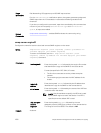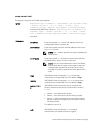
noauth (OPTIONAL) Enter the keyword noauth to specify no
authentication of a packet.
priv (OPTIONAL) Enter the keyword priv to specify both
authentication and then scrambling of the packet.
community-
string
Enter a text string (up to 20 characters long) as the name of
the SNMP community.
NOTE: For version 1 and version 2c security models, this
string represents the name of the SNMP community. The
string can be set using this command; however, Dell
Networking OS recommends setting the community
string using the snmp-server community command
before executing this command. For version 3 security
model, this string is the USM user security name.
udp-port port-
number
(OPTIONAL) Enter the keywords udp-port followed by the
port number of the remote host to use. The range is from 0
to 65535. The default is
162.
notification-
type
(OPTIONAL) Enter one of the following keywords for the
type of trap to be sent to the host:
• bgp — Enable BGP state change traps.
• ecfm — Enable ECFM state change traps.
• entity — Enable entity change traps.
• envmon — Enable SNMP environmental monitor traps.
• eoam — Enable EOAM state change traps
• ets — Enable ets traps
• fips — Enable FIP Snooping state change traps
• lacp — Enable LACP state change traps.
• isis — Enable ISIS adjacency change traps
• pfc — Enable pfc traps
• snmp — Enable SNMP trap
• stp — Enable 802.1d state change traps
• vlt — Enable VLT traps
• vrrp — Enable VRRP state change traps
• xstp — Enable 802.1s, 802.1w, and PVST+ state change
traps
The default is all trap types are sent to host.
Defaults As above.
Command
Modes
CONFIGURATION
Command
History
This guide is platform-specific. For command information about other platforms,
refer to the relevant Dell Networking OS Command Line Reference Guide.
Simple Network Management Protocol (SNMP) and Syslog
1707


















